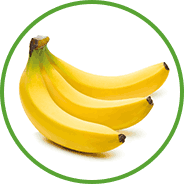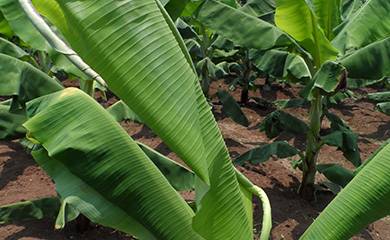
Banana
Banana yield and quality improvement is a major aim of fertilization. Improving fruit storage and quality has become more important since Banana has turned into a mass crop, produced and sold in tremendous amounts. Sufficiently available nutrients lead to a reduction in time needed for maturation of the banana bunches. Foliar fertilization results in a higher return for the grower due to increased shares of marketable bunches with improved quality in terms of physical and chemical character.

Key nutrients:
Potassium is needed in 3-4 times higher amounts than nitrogen. It is required for physiological functions, like accumulation of sugars and starch, synthesis of proteins, cell division and growth in general and it is involved in enzymatic reactions. Moreover, potassium is responsible for boosting plant resistance to biotic and abiotic stresses (esp. drought tolerance). Potassium also plays an important role in terms of transport and production of sugars. It is particularly important since these processes regulate fruit filling resulting in yield increase. Potassium deficiency starts with slow growing leaves. It is followed by a rapid yellowing, beginning on the tip of the older leaves. Yellow leaves dry quickly and the leaf tip curls inward. Later, the dead leaves break near the bottom of the lamina.

Calcium deficiency is a major problem leading to insufficient fruit quality. It is important for the stability of cell walls and membranes which leads to a better plant strength and disease defense. Calcium availability is often negatively influenced by a high nitrogen content, acidic soils and water stress. Calcium deficiency in banana is indicated by a general dwarfing. Leaves are shorter and occur undulated. The tissue near the midrib is thicker than usual and may turn reddish-brown. In subtropical growing areas this appears after spring flush as typical chlorosis and necrosis. The effect on fruit quality is evident when the peel splits during fruit ripening. Moreover, fruits curl and touch others in the bunch.

Though Iron is needed in larger quantities and all micronutrients are essential for a good crop quality, Zinc is of highest importance here. Zinc regulates the water balance and enhances cell membrane integrity. Oversupply of Zinc lowers the mobility rate in the phloem from the leaves to the fruits. Zinc deficiency is observed in all growth regions. Symptoms often occur on young plants without a mother plant acting as a nutrient reservoir. Symptoms may appear without affecting yield in the current year, but having an impact on fruit yield in the upcoming years. Symptoms can be severe on sandy and alkaline soils due to fixation and on low pH soils, where the Zinc content is low. Zinc is inactivated at high concentrations of phosphorus in the soil.
Product recommendation banana

Contact us for more information
Whether you’re interested in more information or just have some questions, we’re here to help. Our experts will be pleased to share their knowledge with you and take care of your request.


